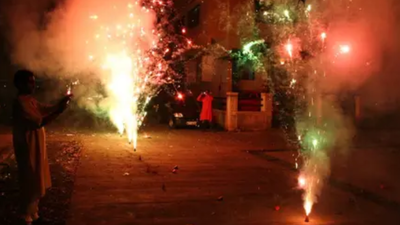NEW DELHI: Had most ambient air quality stations in Delhi not gone on the blink during peak pollution hours on Diwali night and the subsequent morning, the capital’s average AQI the next day is likely to have been much closer to ‘severe’ levels than official data suggests, a TOI analysis of hourly air quality readings reveals.Only eight out of a total of 39 stations logged uninterrupted hourly data in the 24 hours till 4pm, Tuesday, a period that spans Diwali night and the morning after. It’s this data that went into calculation of the city’s AQI for the day after Diwali (Oct 21).

While there are at times gaps in the hourly AQI data, the scale of the outage this Diwali was quite unprecedented. A total of 173 hours of AQI data went missing across 31 stations. Nearly all of this outage, totalling 163 hours of data, happened in the peak pollution period.By comparison, on the day after Diwali last year, 41 hours of data was missing, including 34 hours in the maximum AQI period. All figures are based on hourly AQI data available on CPCB’s website.As per the board’s hourly data, Delhi’s average air quality slipped into ‘severe’ category (AQI of 400+) in the hour ending 10pm on Diwali and stayed in the extreme zone for 13 hours. It shows that during the first hour of severe air, all 39 stations were working. At 1am, when the city’s hourly average AQI peaked at 489 – a level associated with extreme ‘air emergency’ – the number of working stations dropped to 19. By 3am, data was available from just 12 stations, less than a third of the total.TOI had reported on the missing data in the edition dated Oct 22. The report had also quoted Delhi environment minister Manjinder Singh Sirsa refuting it. “All data is available on CPCB and DPCC, there is no missing data,” he had said.Diwali smoke: 23 stns may have recorded levels close to severe However, five days on, the AQI data continues to be missing in CPCB’s website. Delhi officially recorded an average AQI of 351 (very poor) the day after Diwali, a drop of just six points from the previous day’s average of 345. However, if hourly data trends are extrapolated to fill in the numbers missing from stations during the peak pollution hours, the day’s AQI picture changes significantly. Such an extrapolation isn’t too speculative since 29 stations in the city had, before blanking out, recorded an AQI of 500 – the maximum on the scale – and again recorded 500 when data transmission resumed. In these stations, therefore, it’s more than likely that AQI in the “missing” hours had stayed at 500. TOI analysed these trends and extrapolated data for the outage periods. It found that had most of the stations kept transmitting data, Delhi’s average AQI on the day after Diwali was likely to have crossed 380, that is, close to severe. Not just that. The number of stations averaging an AQI of more than 400 (severe) over 24 hours would likely have risen from the current one to eight. While seven monitors had recorded an AQI of more than 380 (very poor, close to severe), the extrapolation shows the number may have been close to 23. In Dwarka Sec 8, Najafgarh, Nehru Nagar and R K Puram, data for at least nine hours was missing. Hence, readings from these stations were omitted in the calculation for the city’s average AQI. Analysis of data for the available hours and extrapolation show these were among the city’s most polluted spots and the day’s AQI at all four was likely to have been in severe range. There’s no official explanation yet for the data outage.
